Nepal is famous worldwide for adventure sports and hiking. Every year hundreds of thousands of people travel to Nepal. Most of them are for trekking to the base camp of Mt. Everest, the highest mountain in the world! I’m going to delve into this guide to Everest base camp trek options and FAQ.
Nestling amidst the peak of the highest mountain in the world, the Everest Base Camp Trek is one of the most popular trekking destinations in the world. More than 40,000 people from all over the world walk the trek every year.
It is one of the earliest opened trial for foreigners. Ever since the successful expedition of Sir Edmund Hillary and Tenzing Norgay Sherpa in the year 1953, the route has been every adventurer’s dream.
PS: See if you need a visa by entering your information on this site.

Guide to Everest Base Camp Trek
The sight of several peaks that you will encounter in this journey will leave you awestruck. Apart from the highest peak- Mt.Everest (8848m), you will also see Mt Lhotse (8516m), Mt. Nuptse (7855m), Mt. Pumori (7161m), Mt. Changaste (7550m), Mt. Lingterin (6679m), Mt. Amadablam (6856m), Mt. Thamserku(6723m), Mt. Kantega( 6685m), Mt.Kusum Khagaru (6367m), Mt.Kongde (6011m), Mt. Khumbila(5761m) , Mt. Twache peak (6367m), Mt. Cholaste (6335m) ,Island peak(6179m), Lobuche peak(6145m), Pokalde peak (5806m), Honku south peak (6119m) and many more.
The trek lies in the Everest Region that is the second best trekking region of Nepal. The region is rich in its composition of flora and Fauna. The walk through the green hills, rhododendron forest, elegant waterfalls, graceful rivers, glacier lakes and Kala Patthar is a phenomenal experience all together.
The region also houses the Sagarmatha National Park, which is listed under UNESCO world heritage site. It is home to several rare and endangered species. You might as well get to encounter some of the exclusive wildlife inhabitants on your way.
Everest region is also draped with a unique culture of one of its kind. Most of the people living in this region belong to the Sherpa community whose lifestyle and tradition resembles to that of the Tibetans. These people are known for their friendliness and open-mindedness.
Before you visit a place, it is always better to have a clear idea about it. This will help you overcome avoidable circumstances. This article is a detail guide of the Everest Base Camp trek so that you can have pleasant journey to the Himalayas.
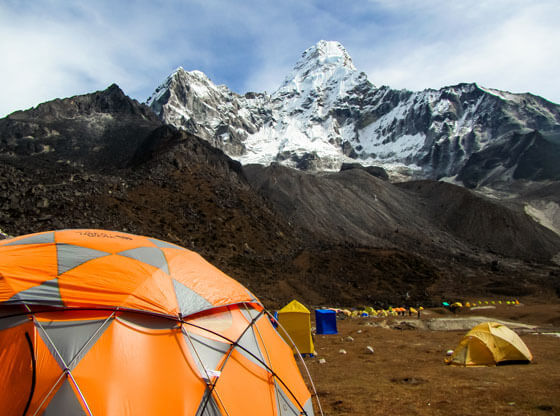
General Itinerary for Everest Base Camp
The general itinerary is the most commonly taken trail leading to Everest Base Camp. You can even have a customized version of the route if you wish spend a longer time exploring more parts of the country. The route to the Everest Base Camp is below:
Day 1: Fly to Lukla (2804 mt.) from Kathmandu, trek to Phakding (2610 mt.)
Day 2: Trek from Phakding to Namche Bazar (3441 mt.)
Day 3: Acclimatization day in Namche Bazar
Day 4: Trek from Namche Bazar to Tengboche(3860 mt.)
Day 5: Trek from Tengboche to Dingboche (4410 mt.)
Day 6: Acclimatization day at Dingboche
Day 7: Trek from Dingboche to Lobuche (4910 mt.)
Day 8: Trek from Lobuche to Gorakshep (5153 mt.) to EBC and back to Gorakshep
Day 9: Hike up to Kalapatthar (5545 mt.) and retreat trek to Pheriche (4210 mt.)
Day 12: Trek from Namche Bazar to Lukla
Day 13: Early morning fly back to Kathmandu
An alternative route is via Jiri to Everest Base Camp Trek, if you want to avoid flying to Lukla.
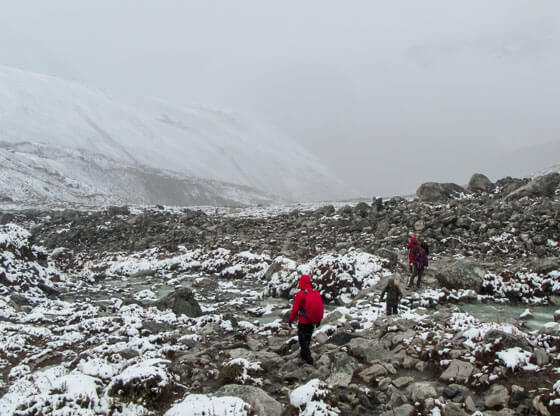
Train your body for the Everest trek
You do not have to be an exclusive athlete to be able to trek to EBC. But you have to be fit enough to enjoy the long walks and to wake up without a sore body. Some of the ways you can train your body are:
- Start exercising about 4-6 weeks before the trek.
- Do Cardio exercises like running, walking, swimming or cycling.
- Carry a backpack while doing cardio exercises.
- Strengthen your muscles by doing squats, pull-ups, push ups, dead lifts, etc.
- Avoid over-exercising. The aim is to increase physical stamina and lung capacity.
What to pack for Everest Trek
You will need several equipment for the trek. The below is a generous list and you may include or avoid according to your needs.
The trekking gears you must have:
- Heavyweight gloves or mittens with a waterproof shell outer
- Down vest and/or jacket (optional)
- Fleece or wool trousers/pants
- Trekking/Hiking boots with spare laces
- Thick, warm wool hiking socks
- Footwear for around camp, example, running shoes and/or sandals
- Gaiters (optional)
You will also need the following during the trek.
- Thermal tops
- Fleece jacket or pullover
- Wind cheater jacket (optional)
- Waterproof shell jacket
- Thermal gloves
- Underwear
- Shorts
- Cotton trousers/pants
- Thermal bottoms
- Sun hat or scarf or Hat or light balaclava
- T-shirts
- Socks
- Sunglasses with UV protection (opt to but this at your home country)
- Sleeping bag rated to 0 degrees (3/4 season)
- Head lamp, spare bulbs & batteries
- Small padlock to lock trek bag
- Plastic bags
- Daypack (35-40 litres/2500-3000 cubic inches)
- Camping mattress
- Water bottles
- Small wash towel
- Footwear (see footwear section below for details)
- Waterproof shell trousers/pants (preferably breathable fabric)
- Toiletries
- Basic first aid kit
Some things to should know about the equipment
- Not all the items from the checklist is a must. You can use your own judgment to make your buying decision.
- You footwear has to be very comfortable and durable. Shoe bites and blisters can ruin the experience for you. The boots should be lightweight trekking boots. Insure that the fabric is good and waterproof.
- Purchase a pair of gaiters to keep your legs warmer.
- Dress in layers so that you can regulate your body temperature as and when required. You can alter the combination of the clothes according to the prevailing weather condition.
- Your clothes should be lightweight and especially designed for trekking.
- Carry along a waterproof shell outerwear, jacket and pants.
- Keep your hands, head and body as warm as possible.
Required Permits for Everest Base Camp
The Everest region is not restricted and hence requires no permit to trek in. If you are looking forward to enter the Sagarmatha National Park then you will have to pay permit fees.
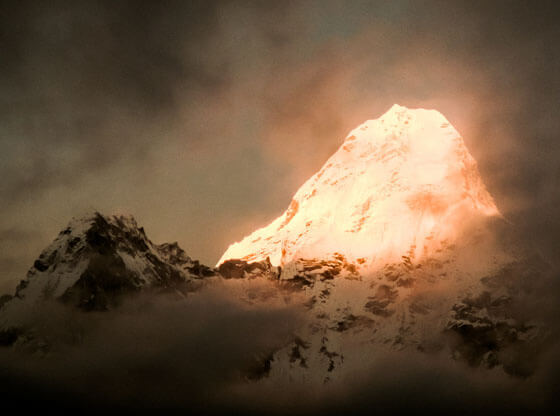
Health concerns
Trekking to high altitudes can result in various risks concerning health. You can easily fall a victim of minor or major injury. The cause of it can be a natural calamity or a careless step. You also might catch common cold, viral fever or have muscles aches.
The most important health issues you need to be aware of before trekking to EBC are below.
Altitude Sickness
This is a kind of illness that is caused by ascent to high altitudes. The symptoms will occur within 6 to 24 hours of achieving a high altitude. Altitude sickness is fatal and can result in death if not treated in time. You need to stay alert to any of the symptoms that occur.
Symptoms
- Headache
- Nausea and vomiting
- Dizziness
- Tiredness
- Loss of appetite
- Upset stomach
- Feeling unsteady
- Shortness of breath
- Increased heart rate
- Difficulty sleeping
Effective measure to recover from early AMS
If you happen to notice any of the symptoms, follow the guideline mentioned below-
- Do not climb any higher for the next 48 hours
- Descend to a lower altitude if possible
- Take complete rest until you feel well
- Do not exercise
- Do not smoke
- Drink plenty of water
- Take external oxygen supply if necessary
- Take anti-sickness medicines
If you see no improvement in your health within 48 hours, you will have to be immediately deported to the city for medical support.
Preventive Measures
There is no way to train your body prior to trekking so as to adapt to the high altitude. Some ways in which you can prevent it are as follows:
- Take plenty of rest
- Ascend slowly and gradually as you reach higher
- keep yourself hydrated
- Eat high calorie food
- Do not smoke, drink or consume tranquilizing medicines
Sunburn issues
In higher altitudes, you are likely to fall an easy prey of sunburn. Make sure you carry an abundant amount of sunscreen lotion of spf 80 at least. Apply the lotion daily.
You will also have to protect your eyes from the harmful rays of the sun. Purchase a good polarized sunglass.

Insurance
During times of emergencies like acute altitude sickness or a natural calamity, you might have to be immediately deported in a helicopter. The cost of such deportation is covered by health insurance that needs to be purchased before you start the trek. Consult any travel agency regarding the purchase of insurance. They should guide you through it. Make sure you do not start the trek without it.
(editor’s note: I use World Nomads Travel Insurance and it’s amazing)
Trekking options
There are several ways in which you can trek to EBC.
- Private Guide with a Porter
- Private Guide with No Porter
- No Guide with Porter
- No Guide and no Porter
- Porter/Guide Combo
- Small Group Tour with Guide with Porter
Hiring a guide and a porter
There is no law to travel with a guide. But it is highly recommended that you do. Guides are people who have a good knowledge and experience about trekking. They will guide you through navigation, suggest you the best place places to stay and eat at, and help you with price negotiations. The guide will also help you during time of emergencies. Before hiring a guide, make sure that he or she is licensed.
A porter is someone who will carry your baggage for you making your journey more comfortable and enjoyable. Nowadays Guide-porter are also available. These are people who earlier worked as a porter and are close to becoming a certified guide. Hiring a guide-porter will save you from extra expenses.
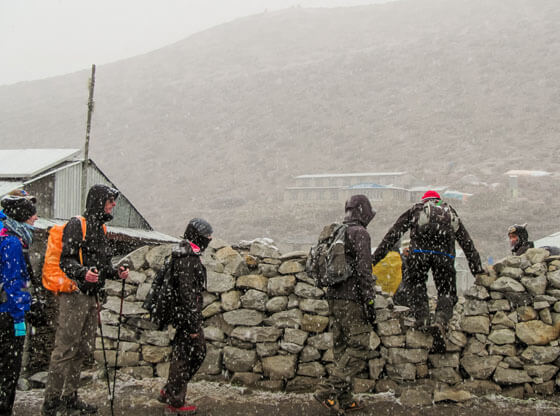 Best season for trekking
Best season for trekking
The best time of the year to trek to EBC is September to December (Autumn) and March to May (Spring). During these months, the weather is pleasant for you to enjoy long walks. There will be very little or no rainfall. The rhododendron forest will be blossoming with flowers especially in the month of May. The skies are very clear allowing you to get the best view of the white Himalayan ranges.
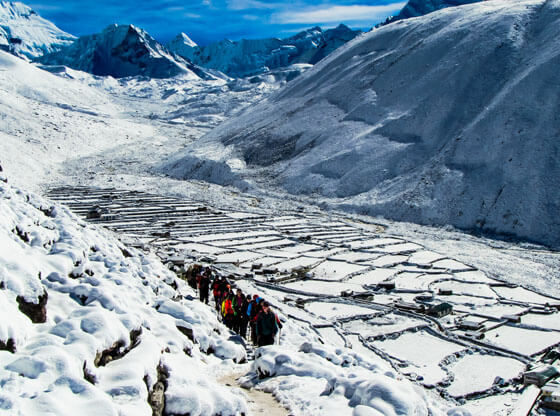
FAQs | Guide to Everest base camp trek
You might have many questions about Everest Base Camp. So I have also included some frequently asked questions.
What kind of food is available?
There are many foods in Nepal that you can try. You will be eating in teahouses. Almost all the teahouses have the same menu. For breakfast, you can have eggs cooked in your preferred style, bread-butter-jam, pancakes, sprouted beans and many more.
For meals, you can have momo’s, pasta, noodles and various other dishes.
The most preferred dish is Dal-Bhaat-Tarkari. Rice is served with vegetable curry, lentil, chutney, salad and meat cooked in Nepali style. You will not be charged extra for taking extra serving of anything but meat.
Is drinking water easily available?
Yes, drinking water is available. But as you go higher, the cost of water will rise up to 1$ per litres. Carry spare water bottle with you and get them filled in teahouses. The teahouses will sell boiled water for a relatively cheaper rate.
How much money should I bring along with me to the trek?
Depend only on cash and not on ATM card. Withdraw all the cash in Kathmandu city itself. Carry along at least 600-700$ cash. If you are on a luxury trek you will need 1800-2000$ cash.
The mentioned amount is an overestimation of the actual cost. Accommodation is available at a cost of 3-4$ per night. A meal should not cost you more than 3$. You might need extra money to buy water, charge your electric devices, tip your guide and porter or pay for their basic need, and buy medicines. It is always better to carry some extra money with you.
What kind of accommodation should I expect?
Do not expect luxurious accommodation. You will be spending your nights in teahouses or tented camps, as you want. The rooms are very simple but comfortable to sleep off the tiredness. Some place will have squatting toilets. While in some guesthouses, you might as well have to share the restroom with other guests.
Where can I buy the trekking equipment?
You can buy equipment from your hometown or Nepal. Nepal had many stores you can buy them from. You will find branded as well as local stores selling trekking gears. The most popular place to shop for them is Thamel situated in Kathmandu. You can also rent most of the items if you want.
Can I carry my electronic devices?
Yes, you can carry your electrical devices and it is absolutely safe. But buy an insulating cover to protect them from extreme change in temperature and pressure.
Carry as many spare batteries as you can for your camera because Nepal has extreme electricity shortage problem. In higher altitudes, the supply is even lesser. The teahouses will allow you to charge your devices only at a certain cost.
Can I trek solo?
You can trek to EBC alone. The route is pretty easy and straightforward. Quite a lot of people trek solo – without a guide or porter or trekking company. However, trekking solo is not advisable when it comes to your safety. Trekking is an adventure sport that involves risks and uncertainties. You never know when you might need help. It is always better to stay on the safer side.
How to find myself a trekking partner?
If you want to travel with a trekking partner, you can find them on this site.
If you want to book a tour and go with a group, you can search the best ones here.
What is so different about travelling with a trekking agency?
There are innumerable trekking agencies in Nepal for you to choose from. Before you decide to travel with one, insure that they are registered and are reliable. Internet can be a valuable tool for you to evaluate them.
In general, a trekking agency will plan your entire trip right from transferring you your hotel from the airport to leaving you off after the trek for your next flight. The team will consist of guides and porter hired by these companies. All you needs will be tended to throughout your trek.
Specifically speaking, the agencies will have few services different from one another. But overall, all of them provide pretty much the same facilities and services, the difference being in the cost and quality of it.
Is there anything else I need to know before I plan the trek?
Always plan extra days than the number of days the trek will cost you. The weather in unreliable and the flights can get delayed or cancelled. You also might confront natural calamity because of which you might get stuck in a particular place for long. Sometimes, the weather in some area might be unfavorable for you to travel and hence you might have to halt for an extra day. You can fall sick. Considering all these possibilities, do not book a flight back to your next destination that is scheduled immediately after the last day of the trek.
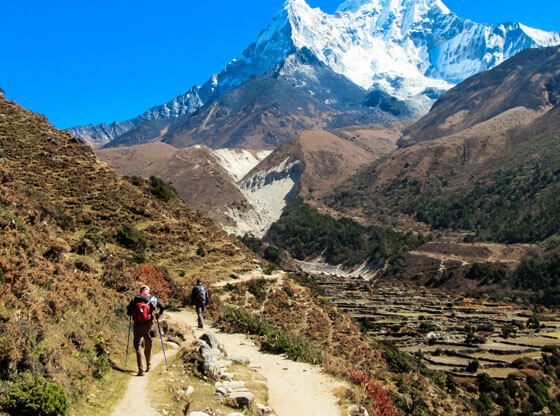
Enjoy your Everest Trek!
Trekking to EBC is every adventurer’s dream. I hope this guide to Everest base camp trek will help your planning. The thought of standing at the Base Camp of the highest peak in the world itself is so exciting. And as difficult as the journey may sound to be, it actually is not. You will have so many things to enjoy and savour along the way that you may not even have enough attention to pay to the body wearing out. And simply by following the tips and advices mentioned in this guide, you will definitely have a pleasant and memorable trip.
Pin this guide to Everest Base Camp trek:
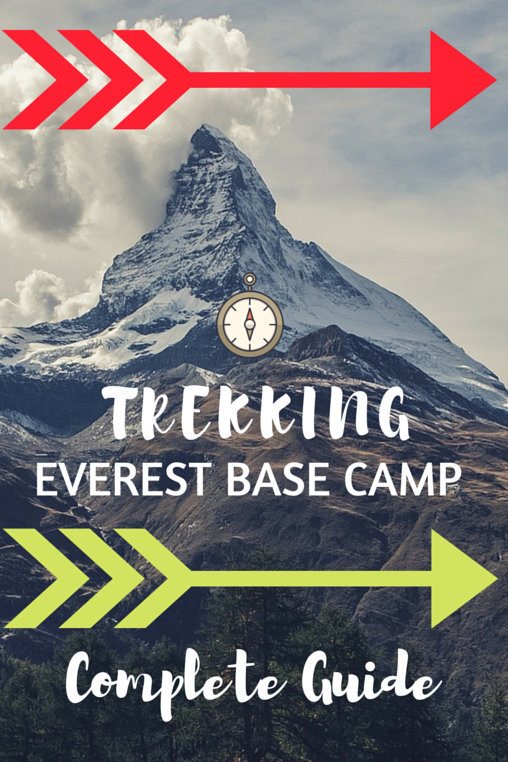
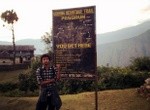 Raushan is a trekking expert from Nepal. He has trekked to several trekking regions in Nepal and his favourite region is Annapurna region, which is considered by many one of the trekking region in the world. Apart from trekking, Raushan loves adventure sports. He blogs about trekking and adventure in Nepal on Trek Route and he could be followed via Twitter and Facebook.
Raushan is a trekking expert from Nepal. He has trekked to several trekking regions in Nepal and his favourite region is Annapurna region, which is considered by many one of the trekking region in the world. Apart from trekking, Raushan loves adventure sports. He blogs about trekking and adventure in Nepal on Trek Route and he could be followed via Twitter and Facebook.


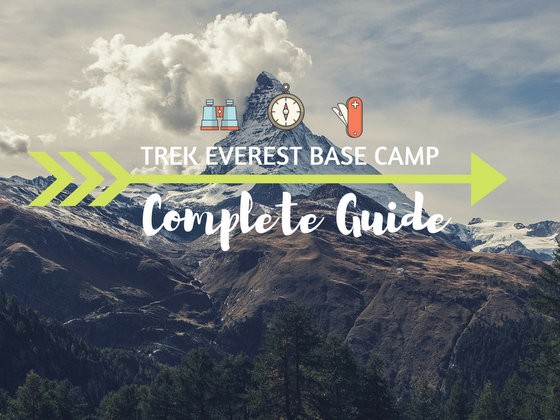
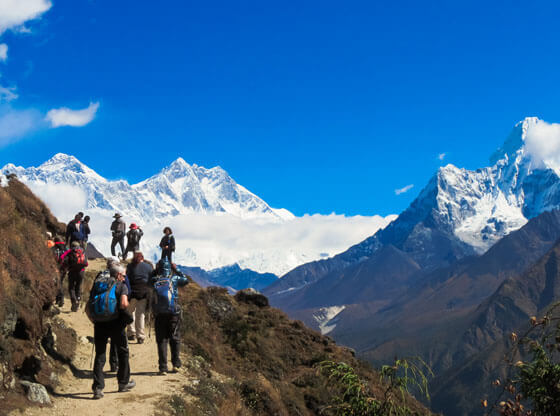

Wow this post was VERY thorough, haha. That’s awesome because I have a friend who is planning to do this and it’s exactly all the info she needs. Thanks!
I know! He gave us SO many tips on every aspect, awesome!
Rachel
Love your blog.
Rosh
Thanks Rosh!
Another advantage of trekking from Jiri is less altitude sickness
Good to know.
Such a detailed and helpful post for people planning to take a trip Everest base camp.
I agree!
Really interesting post – thanks for including it!
A really comprehensive post about going to Mount Everest.
I like the detail about even the smallest thing.
Thanks!
Its complete information for hiking and trekking to Mount Eeverest Base camp Trek. great Job Rachel. keep blogging and traveling. Best of luck!
hii rachel, your information is fantastic and fabulous… recently i have done offroad biking to muktinath which is located at the world famous Annapurna trekking region. i have seen lot of trekkers there but we have done whole trip on bike.. so is there any route towards the everest base camp or some close destinations from where we have to opt minimum trek.. please suggest me if i can ride a bike to some extent to the way to EBC??
Thank you SO much!!! What a fantastic resource you are.
I will be going alone to do the EBC in October.
Do you recommend a small group over a private porter and guide?
I am wondering if it gets lonely traveling alone or if there’s enough people around. I am thinking the benefit of private is flexibility.
Thank you
Such a wonderful blog article regarding Everest Base Camp.
Super awesome information about Everest Base Camp.
Wow! This is so complete! Everything I need to know about my Everest Base Camp trek and all the questions I have in mind are discussed clearly here. Now I can make plan better. Thank you so much!
Additional to national park entry permit you will also need to obtain the local entry permit, which can be obtained in Lukla. Note Trekkers Information Management System (TIMS) Card is no longer needed for Everest Base Camp Trek or any other trekking in Everest Region
We always considered a trek to the Everest Basecamp. Tank you for the thorough information. You touched on everything we need to know.